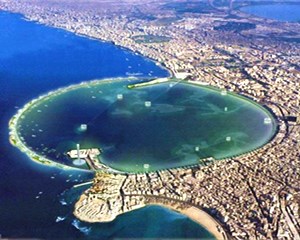When the flood is at the highest, the whole valley and delta of the Nile appear as a vast inland sea, dotted with towns and villages, and scattered mounds, barely emerging from the surface. At this season all communication has to be maintained by boats, save where, between places of importance, a few viaducts have been raised. Between September and December the river subsides, and the land is tilled; and by June the harvest has been reaped. But the cultivators of Egypt need not limit their labours to the production of a single crop: in lands advantageously situated as many as three crops are annually raised by means of artificial irrigation, managed by water-wheels of the simplest construction; the crops being chiefly grain, cotton, and indigo.

Alexandria, the second town of Egypt, and its chief mercantile port, is but a desolate and wretched-looking city, not-withstanding the advantages it has of late years derived from its position in the route of the overland journey to India. The Turkish quarter is yet most filthy and unwholesome, and the mass of the inhabitants are to all appearance plunged in squalor and poverty. This town, which, from its fine harbour, has been termed "The key of Egypt," does not stand on the site of the famous city built by Alexander the Great, which, according to Pliny, was fifteen miles in circuit, and contained three hundred thousand inhabitants. The ancient city, which was burnt to ashes, with its world-renowned library, by the Kaliph Omar, in the year 640, stood to the south of the present Alexandria, on a site which is now covered for the space of six or seven miles in circuit with a confused mass of ruins. Here stands the famous Pompey's Pillar; and hence it was that many of the spoils which enrich the public places and the museums of European cities were derived.












